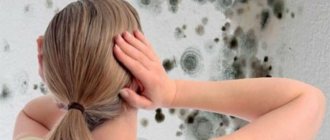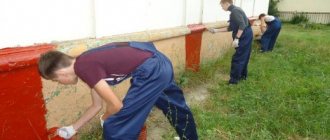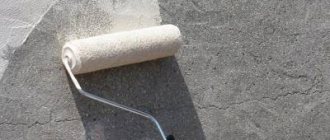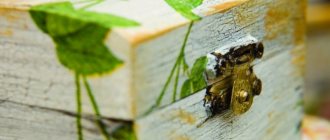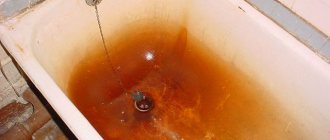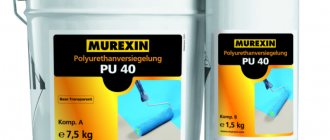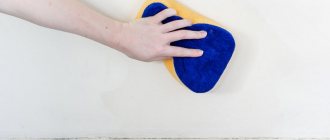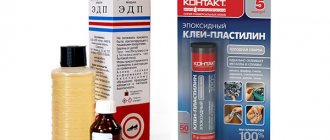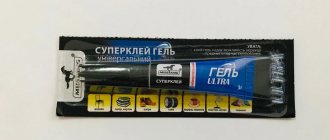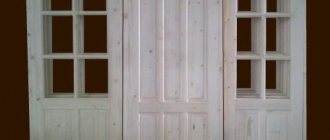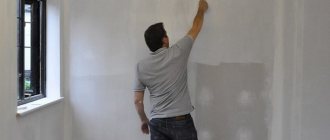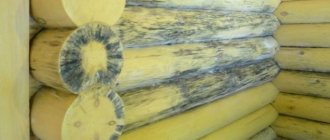Deep penetration antifungal primer for concrete is a means that helps prevent the appearance and proliferation of spores of dangerous microorganisms on the surface. The treatment is carried out using special substances at the final stage of construction, before the start of work on the decorative finishing of the walls.
Due to the fact that concrete has a porous structure, spores of microorganisms very easily penetrate into the base where a favorable environment is created for their growth. The fungus multiplies extremely quickly; treating surfaces is much more expensive and requires much more effort and time than prevention with antifungal drugs.
Danger of fungus and mold
Mold usually appears where concrete bases are exposed to moisture, steam, or strong temperature changes. In residential premises, these are bathrooms, bathrooms, kitchens, rooms where the heating is not constantly turned on, etc. It is better to treat all surfaces where there is a risk of the spread of microorganisms prophylactically, without waiting for a problem to arise.
After all, fungus and mold are very dangerous to health - they release mycotoxins, their spores spread by airborne droplets, quickly enter the respiratory organs, causing a number of health problems: chronic fatigue, decreased immunity, allergic reactions, migraines, diathesis, bronchitis, asthma, rhinitis , otitis. In cases of severe infection, even problems in the functioning of the cardiovascular system, irreversible damage to internal organs, and cancer are possible.
In addition, the spores penetrate deep into the material and the fungus quickly destroys the surface on which it appears. And literally a few months after the first dark spots appear, the finish becomes loose, peels off freely, collapses and literally burns.
Getting rid of fungus is extremely difficult - in the process of treating a surface, you must carefully follow safety rules, wash all clothes at once, use special tools and means to prevent the spread of flying invisible spores further throughout your home, and prevent them from entering the respiratory tract. It is much easier and safer to immediately treat substrates in rooms with high humidity, so as not to give the parasite a chance.
Processing rules
Antiseptic primer is applied according to the same rules that are used when painting surfaces.
Material consumption
The soil consumption is determined by the manufacturer, since this parameter depends on the area and conditions of use, type of surface and other factors. On average, 150-250 milliliters of material are used per 1 square meter.
Required Tools
To apply the primer, you will need a roller or brushes, as well as a container for stirring the solution.
Surface preparation
Before starting work, it is recommended to clean the surface from fungus and mold. To remove the latter from wood, use “Whiteness”; from concrete and brick, use a blowtorch. After this, the surface must be washed to remove dirt and dry.
Applying a layer
The antiseptic primer must be applied with a brush or roller, spreading evenly over the surface. The number of layers in each case is determined individually: in dry rooms - up to two, in wet rooms - up to three.
Drying time and further work
The drying time of the primer is determined by the manufacturer. This process takes from an hour to a day. After the primer has completely dried, you can begin finishing.
Signs and causes of fungus formation
Impregnation against mold and mildew for concrete is used at the stage of repair and construction work. However, for high-quality protection of premises, it is necessary to study the causes of the appearance of fungus and the “symptoms” of infection, which will help to avoid problems in the future and take into account all the nuances.
The main signs of the spread of microorganisms:
1. The appearance of dark gray or black, dark green spots and dots on the ceiling, walls, floor
2. Clearly noticeable damp musty aroma
3. Destruction of the exterior finish - wallpaper peels off, a layer of plaster falls off, wooden panels move away from the base, tile seams darken
4. Deterioration in general well-being in the absence of any diseases - fatigue, poor sleep, headaches, decreased immunity, deterioration of attention and memory
The main causes of mold:
- Poor protection of the base from moisture and cold, ignoring the need to install thermal insulation and waterproofing
- Poor quality processing of interpanel joints, as a result of which they freeze
- Poor condition of the roof, freezing of the attic
- Incorrect installation of window units, absence or poor operation of the ventilation system
- Unprofessional performance of thermal insulation, as a result of which there is no normal vapor permeability
- Unsatisfactory condition of plumbing - pipes are leaking, taps are leaking, water splashes when bathing, stagnates in cracks
Causes of mold
It is almost impossible to detect mold in the early stages, since spores begin to appear in the structure of the surface, destroying it from the inside. The first signs of a fungus that has formed are spots that differ from the color of the finish (brown, gray, black).
Therefore, a deep penetration antifungal primer or a regular antifungal composition should be used at all stages of rough and even white finishing (plaster, putty).
Mold can form in any room. The reasons for its occurrence are most often the dishonesty of builders or defective building materials.
In particular, the reasons for the proliferation of mold fungi are:
- Insufficient waterproofing of the bases, which leads to moisture penetration into the thickness, where it gradually accumulates. The surface is constantly wet, which is what is needed for fungus to grow.
- Cold bases, also susceptible to freezing. Most often, this can be observed in panel buildings, when a defective building block without insulation in the thickness is encountered. Also, freezing walls are a problem in non-residential or seasonally occupied buildings with damaged thermal insulation.
- Poorly sealed interpanel joints.
- Old leaky roofs or fairly cold attic spaces.
- Poor ventilation of the room, including irregular ventilation or poorly installed window units.
- Wooden surfaces or floors that are characterized by excessive moisture absorption.
Primer is a tool for fighting mold
Antifungal impregnation for concrete is a special product, the composition of which is designed to protect surfaces and neutralize mold spores, preventing their appearance in principle. As a rule, such compounds are used to treat floors, ceilings, and walls in rooms with high humidity levels. The work is carried out at the rough finishing stage - the fungicide is added to the primer and guarantees maximum penetration into the pores of the concrete.
Mold can infect a variety of materials, so for each type of work it is worth choosing a product that is suitable for interacting with brick, wood, concrete, etc. In accordance with the purpose, the compositions are ordinary and deep penetration. The second type of product can also be used to treat already contaminated surfaces and is characterized by a longer operating life.
Types of primer by composition:
1) Acrylic – improves the adhesion of materials, is non-toxic, dries quickly, and is used for treating rooms exposed to high humidity (processing the external surfaces of walls, floors, basement ceilings, bathrooms, kitchens, swimming pools, etc.).
2) Alkyd - for glass, plaster, drywall, tiles, wood (the composition protects the wood from swelling).
3) Mineral - for brick and concrete mortar, applied to silicate materials, a layer of plaster, containing cement and gypsum, natural substances, non-toxic.
4) Quartz - applied under the finishing layer of plaster, under paint, contains sand, which guarantees excellent adhesion to surfaces. The final layer is rough.
Substances based on silicate and epoxy resins, shellac, polystyrene, toxic aluminum, polyvinyl acetate, etc. are also used.
Antifungal primer - purpose, properties and application
Manufacturers offer a wide range of anti-fungal products, but each product has its own parameters. Please note that only professional options are designed for deep sanitation of surfaces and complete removal of mold. The bulk of proposals provide only effective prevention. Antifungal primer for walls is usually applied after the damaged plaster has been completely removed from the load-bearing surface of the building. This is done with the aim of creating a barrier between the masonry and a new layer of plaster - preferably cement-lime.
Building mixtures are usually not designed for reuse. Only clay damaged by fungus can be used repeatedly, provided that a solution made with the addition of lime is applied. Lime and clay help get rid of the problem. If plaster is applied to the wooden base of an adobe, frame or timber house, it is recommended to pre-paint the surfaces with a self-prepared sanitizing liquid based on copper sulfate.
Manufacturers offer many different anti-fungal mixtures
All antifungal agents contain fungicides and a base that creates a barrier (acrylic, mineral, alkyd, latex, etc.). For effectiveness, a disinfectant composition is used, providing both antibacterial and antiseptic protection. The difference between antiseptics and fungicides is that the former provide short-term sanitation, the latter – long-term. The anti-mold properties of a liquid coating depend on the amount of certain substances that act against fungus and their penetrating ability.
Depending on the purposes and substances used to prepare the antifungal primer, the purpose, properties and application may vary. For example, some products are used as a surface treatment for areas affected by mold, while others create a strong protection for a new coat of plaster. Depending on the base used, concrete, brick, polystyrene bases, fine-porous and large-porous materials can be processed.
Choose products based on the characteristics of the affected area
Types of antifungal primer
The specifics of using anti-mold impregnation for concrete determine its properties. First of all, all formulations are divided into two main types: for prevention and treatment. Often the concentrate combines both of these properties and is used in diluted form for preventive work and highly concentrated in the treatment of infections.
Products can be oily, adhesive, resinous, demonstrate the ability to absorb moisture, simplify the application of the finish, change its properties and protect. Therefore, the first rule for choosing a substance is to take into account the material on which it will be applied: there are impregnations for concrete, brick, wood, drywall, plaster, protective agents for tiles, etc.
Impregnation against mold and mildew on concrete is intended for use exclusively on this type of surface and is not suitable for other materials.
Types of fungicidal compounds according to action:
- Deep penetration – for strengthening porous surfaces, with penetration up to 5 centimeters
- Adhesive - covered with a thick film with adhesive ability
- Penetrating – for strengthening the composition (plaster and concrete) to a depth of 5 millimeters
- A special-purpose product - with special properties relevant for a specific task: frost-resistant, anti-corrosion, etc.
Based on the type of base, antiseptic compositions are divided into:
1) Water-soluble - diluted with water, low toxicity, used for indoor use. Copper sulfate, which comes in blue powder format, was often used in the past. It is dissolved in a ratio of 1:100 with water and the surface is covered 3-4 times. Calcium fluoride, used as an additive in plaster mortar, belongs to the same type.
2) Organic - very toxic, not used in residential areas, added as an additive when preparing concrete mortar, relevant where there is a high risk of mold.
3) Oil-based (phenol, creosote, carolineum, etc.) – toxic, can only be used externally.
4) Combined - complex chemicals supplied in the form of concentrates. They are diluted with water and used on concrete before applying plaster or as part of it. They guarantee reliable protection provided the right choice is made.
By surface type:
- Strengthening primers - for walls covered with plaster and putty for wallpapering or painting
- Deep penetration primers - for low porosity substrates (concrete, brick, plasterboard, tiles)
- Universal compositions - for any materials.
Types of antiseptics by composition
A wide range of antiseptic primer compositions allows the use of finishing materials for finishing work without restrictions. Specially developed formulations help to significantly strengthen the base, making it resistant to mechanical, chemical and biological destruction. The finishing finishing material lies evenly on the primed base, and it is used sparingly.
Acrylic based
Acrylic antiseptic primer solutions are universal in use and are suitable for processing a wide range of materials. Their difference is a high level of absorption and quick drying. Primer particles penetrate into the base to a depth of 10 mm.
It is recommended to use acrylic compounds to prepare the surface for wallpapering. This reduces the consumption of adhesive, improves the quality of the sticker and simplifies dismantling in the future.
Quartz based
A quartz-based primer consists of acrylic resins and small “sand” particles. It serves as a base coat for applying embossed finishing materials: mineral stone, fiber facade, fiber stone, uniquartz, etc. This type of primer is used on concrete, brick, and plasterboard surfaces. Quartz composition can be applied to plaster and cement. It strengthens the base, improves adhesive properties and reduces the consumption of finishing materials.
Mineral
Mineral primer is used to strengthen and hydrophobize light-colored mineral building materials: limestone, plasters, porous bases. The composition gives the surface the following properties:
- equalizes absorbency;
- forms good vapor permeability;
- significantly strengthens the structure;
- protects against negative external factors;
- increases resistance to biological destruction;
- increases resistance to ultraviolet radiation.
This product combines well with silicate paint.
Alkyd
Alkyd primers are used to treat wood and metal surfaces. The composition strengthens the structure of the base, prevents damage by fungi, putrefactive bacteria, woodworms, and mold.
Alkyd mixtures combine well with PVA, nitro-based paints, acrylic putty and alkyd-based paint products. This type of primer is unacceptable for treating surfaces that tend to crumble: gypsum, plaster, etc.
Deep penetration antiseptic primer against mold
This product is intended for impregnation of highly porous surfaces. The solution particles penetrate to a depth of 10 mm, strengthening the base, increasing its adhesion and preventing the development of harmful microorganisms. Main technical indicators:
- penetration depth – 5-10 mm;
- consumption 50-300 g/m2;
- drying time at room temperature – 1-3 hours;
- operating temperatures – 5-30 ⁰С;
- operating temperature – 40-60⁰С.
The composition of a deep penetration primer can be acrylic, silicone, alkyd, polyvinyl acetate, or epoxy. In addition, there are polystyrene, shellac, silicate, latex and water-dispersion impregnations. Each of the compositions is recommended by manufacturers for treating a specific type of surface.
Working with antifungal primer
Products for walls, floors, and concrete ceilings are selected in accordance with the assigned tasks and the characteristics of the operation of the room. But a number of works are usually performed in a similar way. Each stage plays a very important role in achieving the final result and should not be ignored.
The main stages of surface treatment tasks:
- If this is not prevention, then you first need to identify the causes of the appearance of microorganisms and eliminate them - arrange ventilation, perform waterproofing, change pipes, repair plumbing, etc.
- Using a solution of water and detergent (mostly bleach is used), use a cloth to wash all stains. Burn the rag and everything that interacted with the spores.
- Dry the clean surface by opening windows or using heating appliances.
- Remove contaminated areas of trim.
- Treat the areas freed from infection with a torch or blowtorch, dry and disinfect.
- Clean the surface, remove dust and carbon deposits.
- Apply the primer, wait - it will take a certain time to dry, specified in the instructions for the substance.
- Perform new finishing.
The primer for concrete and mold is applied with a paint brush; in large areas, a roller is used; for large surfaces, a spray bottle is used. The layer of the substance should be dense and even, the calculation is approximately 500 milliliters per 1 square meter, it is better to process several times. To avoid bald spots, layers are applied perpendicular to one another; thanks to rubbing movements, you can be sure that the composition has sunk deeply. It is better to fight inside and outside at the same time.
During work, it is mandatory to use personal protective equipment - close-fitting goggles, a respirator, rubber gloves, thick overalls, and a hat. Upon completion of work, wash the overalls (do not clean them, spreading spores everywhere), wash everything that is disposable - throw it away or burn it.
It is not recommended to use a regular primer on affected surfaces. This product has the property of creating a film on the surface, as a result of which the lesion will be protected, actively growing inward and multiplying.
How to apply primer correctly
In order for the protection to be as effective as possible, the application rules must be followed. The technique differs for different types of compositions, but there is a general algorithm that should be followed.
Surface preparation
The preparatory stage is important, especially when working with a contaminated surface. First of all, you will need to remove the mold using a rag soaked in white. The rag must be burned to stop the spores from spreading. The treated surface should be dried. Then the damaged plastered area is removed. Use a burner to dry and disinfect the surface. Next, carbon deposits and dust are removed, after which an antifungal primer is applied.
Application methods
Important! When covering walls with soil, do not neglect the protection rules. Use personal protective equipment: full-body clothing, gloves, respirator, goggles
Primer manufacturers
- Mill kill - consumption about 250 g/sq.m, the composition penetrates well into walls up to 3 millimeters deep, dries in 24 hours, suitable for interior and exterior decoration, strengthens fragile and porous materials, suitable for use in damp rooms, applied in 2- 3 layers.
- “Areal-Primer” is an acrylic-based substance that includes fungicides of various effects, protects against bacteria, and is important for prevention. Strengthens the processed materials, making it comfortable to work with.
- Elegant 296 is a universal primer for any surface, it insulates, does not allow the substrate to get wet, covers well, creates a film that protects against getting wet.
- Ceresit CT-99 is a concentrate, environmentally friendly, penetrates deeply, retains its properties for a long time, and is used for interior and exterior finishing.
When choosing, they are guided by the conditions of application, the complexity of the lesion, the objectives of prevention, the characteristics of the operation of the premises (residential or industrial), and other factors. By taking into account all the subtleties, it is possible to achieve maximum results.
Prevention measures
Anti-fungal primer for walls is the main way to avoid the spread of mold. Additionally, it is necessary to exclude conditions that contribute to its appearance. Additional preventative measures will help protect your premises from fungus:
- Monitor the condition of water supply systems in order to eliminate the increase in humidity in a timely manner.
- During construction, comply with the requirements regarding hydro- and thermal insulation.
- Carefully seal the joints between parts of the supporting structures.
- Equip high-quality ventilation, especially in kitchens, bathrooms, verandas and other similar rooms.
- If bulky pieces of furniture are located close to the walls, you need to change the layout.
- Ventilate the room periodically.
- Install heating in the house.
- Repair the water supply system in a timely manner.
- Use anti-fungus and mold products.
Mold begins to actively spread in warm conditions if there is high humidity. If such conditions are created in a room, then measures must be taken to eliminate them.
On video: how to prevent mold from reoccurring.
Primers for prevention
They are used where there is a risk of surface damage by fungus and factors predisposing to this, but treatment is not yet required. If the solution is selected correctly and the application rules are followed, there will be no microorganisms in the future.
Milkill – brick and concrete processing
The composition penetrates well into the material and can also be used for treatment.
Acryl grundierung - deep penetration composition
Based on acrylic, consumption about 1 l/15 sq.m., dries in 1 day, water-based paints cannot be worn over the layer, can work at temperatures from +5 to + 35 C, effectively fights fungus and bacteria, ensures good adhesion to the surface, will become Ideal choice for brick and concrete before applying paint and putty.
Schimmelstopp dufa – fungicidal additive
For plasters and paints, it is applied where there is already mold, preventing it from multiplying.
Mixonit gr43 – wide spectrum of action
It is added to dry building mixtures, penetrates deeply, and is applied to various mineral coatings with strong absorption capacity. Without an unpleasant aroma, it forms a breathable coating, penetrates up to 10 centimeters, dries in 3-4 hours, and is not afraid of freezing.
Primer consumption
The consumption of the primer solution is not a constant value. It depends on several factors:
- on the type of surface being treated;
- on application technique;
- from the required number of layers;
- from the manufacturer's recommendations;
- depending on the type of building materials.
In drawing up construction estimates, the statistically derived average consumption of soil material of various compositions is used.
| Type of primer solution | Consumption, g/m2 |
| Deeply penetrating | 80-160 |
| Alkyd based | 100-130 |
| Based on bitumen | 200-10000 |
| Contains perchlorovinyl | 600-100 |
| Acrylic based | 120-180 |
Properly organized thermal insulation and ventilation of the house will help to avoid unwanted humidity and the formation of mold colonies. A correctly selected primer will be the best preventative against dangerous microorganisms. This material will protect walls and ceilings from destruction, extend their service life and preserve their appearance for a long time.
Antifungal agents for wood
Wood is most susceptible to fungus, as it easily absorbs moisture, gets wet, is a natural substance, and creates a favorable environment for the proliferation of microorganisms. The tree is treated with insecticides in several layers, preferably repeated once a year.
Dufa holzlasur – glaze for wood
Decorative thin-layer composition that restores and protects materials from precipitation. It destroys parasitic spores well and does not allow new ones to appear. A large number of tones, dries in 4 hours.
Baramon S30 – stable impregnation
Does not wash out, protects against mold and insects, and removes those that have already spread. It crystallizes within 2 days, then lasts a long time, consumption is 200 ml/sq.m inside and 300 ml/sq.m outside, not suitable for wood species that are difficult to impregnate (oak, for example).
Pinotex base – treatment of external walls
On an alkyd basis, it is applied to protect windows, doors, facades, fences before the painting stage, increases adhesion with the topcoat, dries in 12-24 hours, only dry wood can be processed.
Types of antiseptic primers according to the surfaces used
Antiseptic primer solutions are produced in an assortment, taking into account the specifics of their application. An important classification criterion is based on the material of the processed base.
Antiseptic primer for wood
Priming is a mandatory stage of processing a wooden surface before finishing. This measure increases adhesion, reduces hydrophilicity, and protects against putrefactive bacteria, mold and woodworms. In addition, the primer helps preserve the natural color of the wood, protects against fading and destruction of the structure.
Coating wooden bases with a primer mixture is especially necessary:
- when used outdoors;
- in conditions of high humidity;
- if there are defects in the structure of the tree;
- before painting.
To cover wooden surfaces use:
- Acrylic compositions. They are white in color and are well suited for preparing for the application of plaster and paint coatings.
- Alkyd products. Transparent and colored compositions are applied before using alkyd enamel or as an intermediate layer between two paints.
- Shellac primers. These products are well suited for conifers. They neutralize the effect of tree resins.
Wood with low porosity requires the use of a liquid consistency primer.
Antiseptic for drywall
Drywall is subject to mandatory priming before applying the finishing finish. This increases its hydrophobicity, protects against mold, increases adhesion and strengthens the structure of the building material. Special moisture-resistant plasterboard GKLV does not require priming.
The primer solution gives the plasterboard surface the necessary properties:
- the absorption capacity is leveled over the entire area, the quality of applying the finishing layer is improved;
- the formation of lumps of the finishing product during application is prevented;
- interaction with water after drying is prevented;
- resistance to mold and fungi increases.
A suitable primer for drywall is acrylic. It dries quickly, absorbs evenly and is safe for internal use.
Antifungal primers for concrete
Concrete consists of cells and pores into which water easily penetrates. A wet base loses its strength and fungus develops on it. The primer composition creates a hydrophobic film on the concrete base that protects against mechanical destruction, chemical attack and biological corrosion. The service life of the surface increases.
There are several types of primers for working on concrete:
- Polystyrene – recommended for exterior finishing (contains caustic solvent). Provides frost resistance and waterproofing.
- Polyvinyl acetate - suitable for indoor work. Dries relatively quickly (in 40 minutes), providing high adhesive properties.
- Epoxy - used for arranging self-leveling floors. The primer increases the service life of concrete, but is limited for indoor use because... contains a solvent.
- Alkyd – universal, suitable for all types of finishes, but dries in about 17 hours.
- Acrylic is the most popular. It is non-toxic, quickly absorbs and dries, and protects walls and floors well from destructive factors.
- A deep penetration primer strengthens the structure of concrete, compacts it, and protects it from moisture and mold.
- The mixture with quartz strengthens the base and increases adhesion.
Note!
An antiseptic must be included in the primer for concrete, especially if it is used in conditions of high humidity.
For wet areas
The antiseptic primer used in wet rooms has a reinforced composition. In these cases, deep penetration compounds and surface-type polyurethane coatings are used.
Penetrating compounds consist of epoxy resins, acrylates and are available in the form of concentrates. After application, deep penetration, polymerization and formation of a hydrophobic layer occur.
This type of primer is used:
- for leveling walls made of concrete and brick;
- for waterproofing a layer of plaster with further painting and putty;
- to prepare the base for gluing tiles;
- to impart moisture resistance to drywall.
Primers based on polyurethane and epoxy are used for waterproofing when installing self-leveling floors.
For dry rooms
In dry rooms, primers that meet safety standards are used. They should not contain toxic substances or harmful compounds. Along with safety, it is necessary that the composition strengthens the surface of walls and floors, increases its adhesion and protects it from fungal plaque.
A universal option is water-based acrylic emulsions. They are easy to apply, dry quickly, and meet safety requirements.
For external priming work
The main objectives of the primer for exterior work are to strengthen the surface of the walls, protect them from precipitation, and extend the service life of the facade. The composition serves as an insulating layer and does not radically change the appearance of the surface. In some cases, the primer is used as a finishing coat. Most often, two types of primers are used for exterior work:
- The acrylic composition contains polymer resin, plant components, sand, etc. It is used for external processing of wood, concrete, brick, stone, chipboard, aerated concrete and is economical in consumption. Must be used at an ambient temperature of at least -15⁰С.
- Alkyd products are well suited for protecting reinforced concrete structures from corrosion, and wooden structures from rot and mold. They are applied before coating with paint or plaster.
By applying an antiseptic primer, you can significantly increase the service life of a building and preserve the aesthetics of the facade for many years.
Emulsions to combat mold
The products are designed to remove foci of fungal infections, to do this quickly and effectively, but safely and without destroying materials. The substances are used at the stage of repair work before the finishing coating, guaranteeing improved properties of concrete: eliminating mold, reducing porosity, improving adhesion, strengthening the base.
Ceresit ct 99 – long-lasting action
A completely safe concentrate that can be used to treat external and internal mineral surfaces (plaster, brick, concrete). There are no heavy metals in the composition, only organic biocides, it leaves no traces on the surface, it is permeable to steam, dries in 4-5 hours, operating temperature is +5-40C.
Abedis 06 - removal of organic plaque
Apply to brick, plastered surfaces, concrete paths, tiles for preventive effects. The concentrate is diluted with water in a ratio of 1:2, a day after work, the wall is washed with water and dried, if necessary, re-treated after 36 hours.
Dali - universal antiseptic
Works as a preventative impregnation before painting where fungus has already lived. Apply to plaster, brick, concrete. The solution consumption for prevention is 50-100 ml/sq.m, for treatment – 50-250 ml/sq.m, repeated after 6 hours.
Fongifluid alpa – treatment and prevention
Removes foci of infection and prevents them from reappearing and spreading. Suitable for brick, wood, plasterboard, ceramic and other surfaces. You can also process cement plaster and tiles. Does not interfere with air penetration, allows materials to breathe, positively influencing the microclimate in the room. Consumption is about 1 l/4-5 sq.m., dries in 6 hours, the base can be painted only after 6 days.
The solution is highly effective against large volumes of microorganisms and does not change surface properties such as texture, shine, or color.
Causes of fungal pores and their danger to humans
We apply an antifungal primer mixture to the walls ourselves
Mushrooms that grow in the forest and black spots of mold on the walls are relatives. They come in different sizes and degrees of utility. The latter, like all parasites, are much more tenacious than their edible relatives, bring a lot of trouble, and are difficult to remove.
Mold requires certain conditions to grow. The main thing is moisture, or rather dampness. It can form for various reasons.
- In case of violation of foundation waterproofing. Soil moisture rises up the wall.
- Freezing of walls with poor protection of the facade from moisture.
- Violation of the rule of vapor permeability during insulation, then the moisture does not come out, but remains inside.
- The use of finishing materials that do not allow air to pass through and the walls cannot breathe. Porous textures of wood, plaster.
- Leaking pipes at joints and small cracks.
- Formation of dew in plastic windows.
- Poor ventilation in the kitchen, bathrooms and utility rooms.
The smell of stale air is created by millions of pores flying around in the room. They are harmful to humans. Entering the body through the respiratory system, they can cause a number of serious diseases. The fungus takes deep roots in wall materials and promotes rapid destruction.
Related article: What can you make from leftover laminate flooring with your own hands?
Traditional methods against mold
- Bleach - sodium hypochlorite kills spores, but corrodes the surface and destroys decorative finishes. It works only from above, it does not penetrate inside, so the effectiveness is low, and if there is a negative impact on health, its use is not relevant.
- Baking soda + bleach + liquid soap + essential oil – removes parasites from the surface layer of the finish, the effect remains, but if the spores remain inside, they will reappear after a while.
- Hydrogen peroxide - removes fungus, but whitens surfaces, apply a 3% solution with a spray bottle.
- Vinegar destroys bacteria, is non-toxic, but has an unpleasant aroma; after treatment, you need to ventilate the room.
- Baking soda - spray the wall with a solution of 1 teaspoon of soda and a liter of water, after an hour wipe with a dry cloth, leaving a little product to prevent the spores from spreading in the future.
- Sodium tetraborate (borax) is environmentally friendly, effective, and can be purchased at the pharmacy.
- Ammonia - used in its pure form, does not mix with bleach (poisoning due to toxic gases released during the reaction), household cleaners with ammonia and chlorine.
Why does mold and mildew occur?
Fungal spores can appear anywhere, but their development will begin only when the most favorable conditions are created.
They develop in humid environments with poor ventilation. Therefore, very often these problems arise in the bathroom.
If mold suddenly appears in the room, you should first solve the problem of high humidity and poor ventilation.
Otherwise, it will appear again and again, even if super effective means are used to eliminate this scourge.
Calculation of antiseptic volumes
An antiseptic will save you from mold and mildew, but only if you calculate it correctly and determine the sufficient quantity and volume of primer. At the very beginning, it is worth calculating the area of the surface to be treated. And already on the packaging of the corresponding composition, the manufacturer indicates the volume of material consumed. So, the consumption of antifungal primer and material is calculated per square meter, and for example, 6 kg will be needed for 10 square meters. solution.
If the surface is primed two or three times, appropriate changes must be made to the calculations themselves. But the waste of material can be reduced by thoroughly cleaning the surface to be treated, then apply the primer itself and then cover it with a prepared disinfectant.
Benefits of primer
Antibacterial primer contains fungicides - special substances that can destroy harmful microorganisms. Additionally, priming performs the following tasks:
- reduces the consumption of subsequent finishing materials (paint, plaster, wallpaper, etc.);
- the quality of finishing is improved;
- eliminates the occurrence of cracks after painting;
- increases the durability of the finish;
- neutralizes unpleasant odors during painting;
- creates a coating that can repel moisture;
- prevents the processes of decay of the material.
After applying the antifungal primer, further surface finishing is performed. This includes puttying, applying plaster, paint, waterproofing materials, wallpapering, and installing facing tiles.
Priming is used to treat walls, floors and ceilings of a room. It is especially important to protect external walls that are exposed to precipitation from fungus.
Primer
This product can completely eliminate the formation of stains on the walls. It can not only remove them, but also prevent further formation.
This primer can be purchased at any building materials store.
It is quite simple and easy to use. During use, it does not need to be diluted with water; the solution should be applied in its pure form.
Also, when using the product, it is advisable to read the instructions completely. This will help remove stains most effectively.
